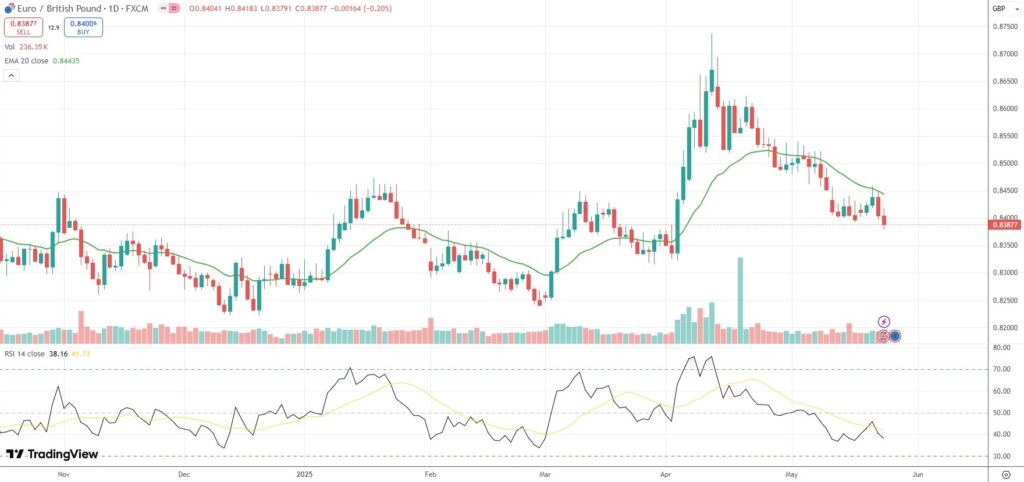EUR/GBP settles above 7-week low, posts weekly loss
The EUR/GBP currency pair settled above Friday’s low of 0.8379, its weakest level since April 3rd, after a stronger-than-anticipated UK retail sales growth and renewed relief among UK households over
The EUR/GBP currency pair settled above Friday’s low of 0.8379, its weakest level since April 3rd, after a stronger-than-anticipated UK retail sales growth and renewed relief among UK households over an upcoming drop in energy prices.
At the same time, Euro Area’s negotiated wage growth slowed markedly in Q1, supporting the case for further ECB interest rate cuts.
Data by the Office for National Statistics showed on Friday that retail sales volumes had risen 1.2% in April compared to March, beating economists’ forecasts of a 0.3% gain. This marked the fourth consecutive monthly growth, the first of its kind in almost five years.
Food store sales saw a notable rebound, climbing 3.9% after consecutive declines in the preceding two months. Yet, clothing and footwear sales declined over the month despite gains in department stores, household goods outlets and non-store retailers.
Ofgem further relieved pressure on UK consumers by imposing a 7% decrease on the country’s energy price cap. Effective July, this cut follows a series of prior hikes.
ECB rate cut prospects, fresh US tariff threats mount pressure on the Euro
In the Euro Area, new ECB data showed negotiated wages rose 2.38% year-on-year in the first quarter of 2025. It has been the smallest YoY increase since Q4 of 2021 and followed a 4.12% YoY growth in Q4 of 2024. The data aligned with the European Central Bank’s view that wage-driven inflation pressures were diminishing.
Markets have priced in an increased chance that the European Central Bank would lower interest rates next month. Although several ECB officials have voiced confidence that inflation is nearing the 2% target, some caution remains. ECB Governing Council member Klaas Knot said this week he could not rule out the possibility of another interest rate cut in June, but he could also not confirm it.
In other data, Germany’s private sector went back into contraction territory in May, weighed down by a sharper downturn in services activity that offset manufacturing’s modest rebound.
According to flash estimates from S&P Global and Hamburg Commercial Bank, the HCOB Flash Germany Composite PMI Output Index declined to 48.6 in May, 1.5 lower than April’s 50.1 and below the anticipated 50.4.
Meanwhile, Germany’s Ifo Business Climate indicator rose to 11-month high in May, at 87.5 and against estimates of 87.4.
”The recent sharp rise in uncertainty among companies has eased somewhat. The German economy is slowly regaining its footing,” Ifo President Clemens Fuest commented.
Germany’s quarterly GDP growth has now been revised up to 0.4% in Q1 of 2025 from 0.2% in the initial estimate.
On the trade front, US President Donald Trump said on Friday that he was recommending a flat 50% tariff on all products imported from the European Union, effective June 1st.
He shared the announcement via his Truth Social platform, citing what he described as an imbalanced and unfair trade relationship between the US and the EU that he claimed resulted in a yearly trade deficit of over $250,000,000 for the US. Trump also stated that discussions with the European Union were “going nowhere.”
The announcement reignited investor concerns over the impact of tariffs on global economy.
The EUR/GBP currency pair settled 0.20% lower at 0.8388 on Friday.
The minor Forex pair lost 0.11% for the week – its sixth straight weekly decline.

Disclaimer: The views in this article are from the original Creator and do not represent the views or position of Hawk Insight. The content of the article is for reference, communication and learning only, and does not constitute investment advice. If it involves copyright issues, please contact us for deletion.